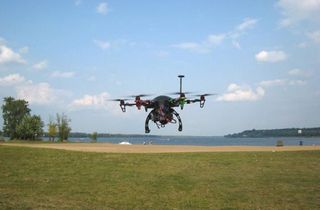Geese-Scaring Drone Keeps Beach Clean

Canadian lawmakers have enlisted a drone to disperse a large flock of Canada geese at a popular beach this summer, pleasing swimmers concerned about water quality.
Canada geese are relatively harmless, but their droppings — which can contain harmful bacteria such as E. coli — pose a public health threat when present in large quantities. Such threats have become increasingly common across Canada in recent years as these birds have increasingly flocked to public spaces, likely attracted to food sources such as lawn grass and trash.
Petrie Island, a swimming beach in Ottawa, Ontario, has become one such popular resting spot for the birds, with a flock of about 150 geese feeding there this summer. In the past, the city has used tactics such as sound blasts and trained dogs to try to encourage the geese to find an alternative spot to feed, but the birds continue to return there. Last year, they caused a 13-day beach closure due to unsafe E. coli counts.
Ottawa City Councilor Bob Monette has decided to take a novel approach this year by commissioning an Ottawa resident to design a drone to scare away the geese, permitted by the Canadian Wildlife Service and several other governing agencies. [9 Totally Cool Uses for Drones]
In the three weeks that the drone has operated since July, it has reduced the flock down to an average of about 15 per day, Monette told LiveScience.
"The beach has not been closed one day since the start of the program this year," Monette said. "It's a vast improvement."
The remote-controlled vehicle flies with six rotating blades, spans about 26 inches (66 centimeters), and is outfitted with lights and audio recordings meant to frighten the geese without harming them. The recordings include sounds of potential predators, including owls, fox, wolves and eagles, and play at varying intervals to prevent the birds from becoming comfortable with repeating repertoires of empty threats.
Sign up for the Live Science daily newsletter now
Get the world’s most fascinating discoveries delivered straight to your inbox.
"Geese are extremely intelligent and very adaptive, so if you hit them with the same sounds all the time, they are going to learn to ignore it," said Steve Wambolt, the designer and operator of the drone who spends six hours each day flying the vehicle on the beach. "Sometimes, I go down and play the sounds, sometimes I have the light on, sometimes I don't."
Wambolt often arrives at the beach at 4 a.m. local time when the geese first land, and then returns at various times throughout the day for short spurts of flight. He plans to continue this daily routine through the end of October, when most of the birds will have started migrating southward to the United States.
"The idea is that, in Canada, we have enough green space to accommodate the geese population," said Wambolt. "We just need to convince them to go there."
The broader ecological effects of the drone remain unclear, but Wambolt has noticed that squirrels and groundhogs seem to be afraid of it.
"It would be interesting to study to see if other animals are actually detecting these noises, and whether they are reacting to these noises on the short and long term," said Julie Morand-Ferron, a biologist at the University of Ottawa.
The ecological impact of the drone on the birds likely remains minimal though, Morand-Ferron said, since the birds are not endangered and have many alternative options for resting spaces nearby. If Petrie Island were a nesting or breeding site, which it does not appear to be this year, then the drone may start to become a more significant ecological problem.
Monette hopes to use similar devices in other parks around the city if the procedure works, in an effort to reduce health threats in public spaces.
Follow Laura Poppick on Twitter. Follow LiveScience on Twitter, Facebook and Google+. Original article on LiveScience.


Declassified spy satellite images reveal 1,400-year-old battle site in Iraq that set off the Muslim conquest

'The bottom line is, I told you so': JWST observations upend standard model of how galaxies form, new study claims

James Webb Space Telescope discovers mysterious 'red monster' galaxies so large they shouldn't exist